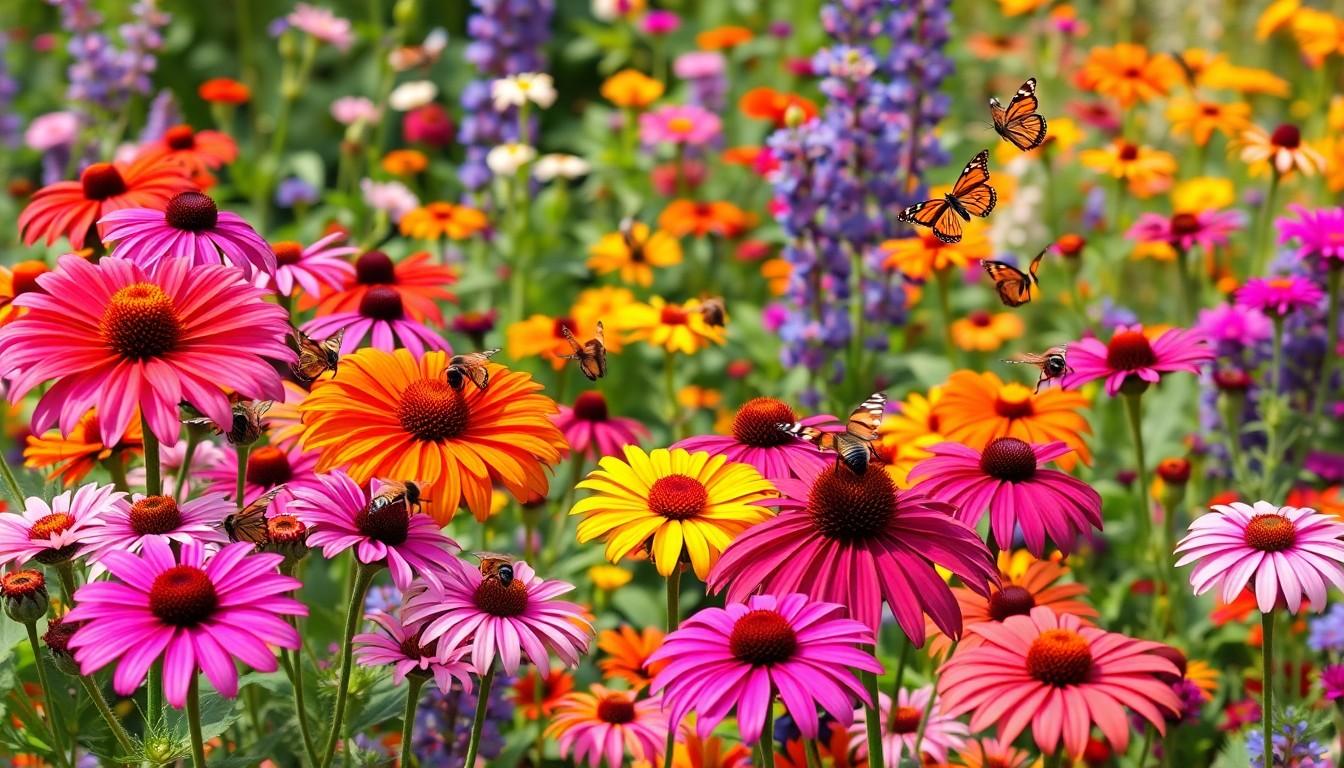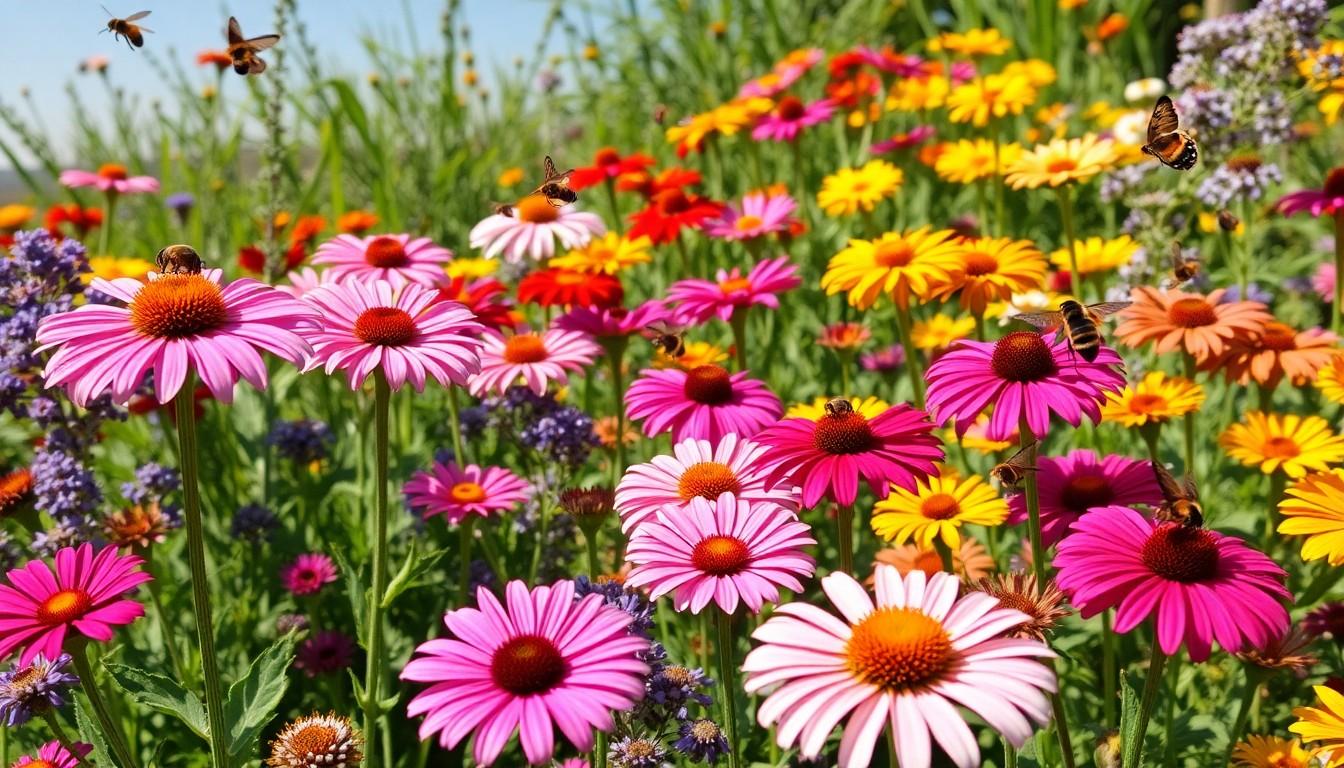Imagine a garden buzzing with life and color, where bees and butterflies flit from flower to flower, creating a vibrant ecosystem. Not only do these pollinators add charm to any outdoor space, but they also play a crucial role in maintaining our food supply. By choosing the right flowers, anyone can transform their yard into a pollinator’s paradise.
Overview of Pollinators
Pollinators like bees and butterflies are essential for maintaining healthy ecosystems. Their role in plant reproduction directly affects food production and biodiversity.
Importance of Bees and Butterflies
Bees and butterflies significantly contribute to the pollination of about 75% of flowering plants. This process supports the growth of fruits, vegetables, and nuts. Pollinators enhance biodiversity, which fosters resilient ecosystems. Their activities result in the production of seeds, fruits, and a variety of foods essential for human consumption. Moreover, increased pollinator populations lead to healthier plants that provide habitats for other wildlife.
Threats to Pollinator Populations
Pollinator populations face numerous threats that threaten their survival. Pesticide use continues to decline bee and butterfly numbers significantly. Habitat loss due to urban development and agricultural expansion also plays a crucial role. Climate change affects flowering times, leading to mismatched relationships between pollinators and plants. Additionally, diseases and parasites harm pollinator health, resulting in reduced populations. Recognizing these threats urges action to protect and preserve these vital species.
Top Flowers That Attract Bees and Butterflies

Selecting the right flowers can transform any garden into a sanctuary for bees and butterflies. Various native and exotic flower options provide the necessary nectar and pollen these pollinators crave.
Native Flower Options
Native flowers naturally attract local bee and butterfly populations. Plants like coneflowers provide essential nectar, attracting bees and butterflies alike. Milkweed serves as a critical habitat for monarch butterflies, facilitating their lifecycle. Black-eyed Susans appeal to a wide variety of insects, enhancing biodiversity in gardens. Aster blooms later in the season, offering food when other resources dwindle. These plants represent a sustainable choice, creating a resilient ecosystem.
Exotic Flower Choices
Exotic flowers also encourage pollination by drawing in diverse pollinators. Lantana, with its vibrant clusters, attracts butterflies and is drought-tolerant. Salvia, known for its strong fragrance, appeals to many species, including hummingbirds. Zinnia offers bright, cheerful blooms that draw bees and butterflies throughout the summer. Additionally, cosmos provide accessible pollen and nectar while adding color to any landscape. Incorporating these flowers enriches gardens and supports pollinator health.
Planting and Care Tips
Creating an environment that fosters pollinators requires thoughtful planning and care. Attention to optimal growing conditions and maintenance best practices enhances the chances of attracting bees and butterflies.
Optimal Growing Conditions
Flowers thrive in well-drained soil rich in organic matter. Sunlight plays an essential role; full sun exposure, around six to eight hours daily, promotes robust growth and blooming. Watering practices matter too; consistent moisture in the early stages establishes strong roots, while avoiding soggy conditions prevents root rot. For those residing in areas with particular climate challenges, choosing drought-resistant or native varieties adapts better to local conditions. Spacing is crucial; adequate space between plants ensures proper air circulation and reduces disease susceptibility.
Maintenance Best Practices
Regular monitoring of flower health supports vibrant blooms. Check for pests and diseases; early detection allows for prompt intervention. Deadheading spent blooms encourages additional flowering and keeps plants looking tidy. Mulching around the base retains soil moisture and suppresses weeds, fostering a more conducive environment for pollinators. Fertilizing can enhance growth, but balance is key; utilizing organic options minimizes chemical exposure. Periodic pruning of overgrown plants improves airflow and sunlight access, further benefiting overall plant vitality.
Creating a Pollinator-Friendly Garden
A pollinator-friendly garden thrives on diversity and continuous blooming. This approach supports vital insect populations like bees and butterflies.
Designing with Diversity
Deciding on a diverse selection of plants ensures a vibrant ecosystem. Incorporating various colors, shapes, and sizes attracts different pollinators. Native plants such as coneflowers and milkweed provide essential nutrition. Exotic options like lantana and zinnia can also enhance beauty and draw attention. Grouping flowers in clusters increases visibility for foraging insects as they find preferred nectar sources more easily. Overall, mixing native and exotic flowers creates a dynamic environment favorable for pollinators.
Seasonal Blooms for Continuous Attraction
Selecting flowers that bloom in different seasons guarantees ongoing support for pollinators. Spring blossoms such as tulips and daffodils offer early nourishment, while summer favorites like black-eyed Susans and asters keep the food supply steady. Fall-blooming flowers, including goldenrod and sedum, provide essential resources as insects prepare for winter. Ensuring that something blooms from early spring to late fall maintains pollinator activity year-round. This intentional planning cultivates a garden that becomes a reliable sanctuary for bees and butterflies.
Conclusion
Creating a garden that attracts bees and butterflies is more than just an aesthetic choice. It’s a commitment to fostering biodiversity and supporting essential pollinator populations. By carefully selecting a variety of native and exotic flowers gardeners can ensure that their outdoor spaces remain vibrant and alive with activity.
Implementing best practices for planting and maintenance not only enhances the beauty of the garden but also contributes to the health of local ecosystems. As these pollinators thrive in well-planned environments they play a crucial role in sustaining food supplies and promoting ecological balance.
By taking action to protect these vital species everyone can enjoy the benefits of a flourishing garden while making a positive impact on the environment.

